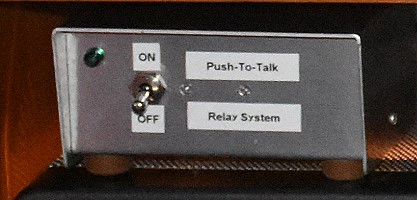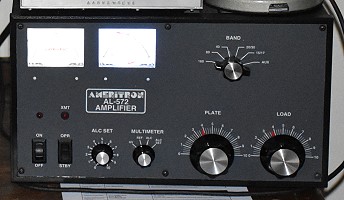
Click on any item in the photo for information on that item, or look in the list below.

<Previous Section |
Back to the The AA8V Station Page |
AA8V Station Main Page> |
| Section 5 (Left Side of Photo) | Section 6 (Right Side of Photo) |
| Sections 5 and 6 Introduction | AA8V Wingfoot 813 Linear Amplifier |
| Coaxial Antenna Relay | Astatic D-104 Microphone |
| Johnson Viking Ranger AM Transmitter | Ameritron AL-572 Linear Amplifier |
| PTT Relay System | |
| Hallicrafters SX-96 Receiver |
Introduction:
Section 5 (Left Side of Photo):
Section 5, on the right in the photo, contains a complete 1955 vintage AM
station consisting of a restored Johnson Viking Ranger AM transmitter and a
restored Hallicrafters SX-96 receiver, along with their associated accessories:
a push-to-talk (PTT) relay system and an antenna changeover relay.
Section 6 (Right Side of Photo):
Section 6 of the station features a pair of high powered amplifiers. At top is
the Wingfoot 813 Amplifier, and at bottom is the Ameritron AL-572. The Wingfoot
813 Amplifier is a homebrew amplifier for the 80m, 40, 30m, and 20m bands with
an output of 250W. The Ameritron AL-572 is a commercial amplifier with an
output of 1000W on CW and 1300W PEP on SSB.
| Coaxial Antenna Relay: A coaxial antenna relay is used with the Johnson Viking Ranger and Hallicrafters SX-96 receiver as part of a push-to-talk (PTT) system. When the PTT on the microphone is pressed, the PTT system activates the antenna relay, switching the antenna from the receiver to the transmitter. The relay can also be used in CW mode with the automatic T/R system. In this mode, the 6x2 receiver or the Jupiter receiver can be used with either the Johnson Ranger transmitter or the 6AG7/6146B transmitter system for fully automatic transmit/receive switching. |
 |
| Johnson Viking Ranger AM Transmitter: In the middle and late 50s thee most coveted transmitter for any ham running AM was the Johnson Viking Ranger. It was the transmitter to have if you were running AM. With the ability to run on 160m - 10m, it featured a built in VFO and high level plate modulation with a powerful, great sounding modulator. With a handsome front panel and the ability to meter five different circuits the Viking Ranger set the standard for AM operation. The Ranger wasn't cheap. In 1955, a factory assembled Ranger cost $293, the equivalent of over $2500 in 2015! This particular Ranger was factory assembled, and it is fully restored. However, even after restoration the internal VFO is not as stable as I would like. Rather than use the internal VFO, I use my digital VFO and feed the VFO signal in through the crystal socket. The digital VFO works beautifully with the Ranger, and gives me absolute stability and digital frequency readout. |
 |
| PTT Relay System: When running AM, I prefer to use a push-to-talk (PTT) relay system. Rather than modify the Ranger, I simply feed the PTT line from the microphone to this external PTT relay system. On the back panel the relay system has a 120V AC outlet that is normally off, along with a normally closed RCA jack and a normally open 1/4" keying jack. A coaxial antenna relay is plugged into the 120V outlet, the receiver mute circuit is connected to the normally closed RCA jack, and the transmitter key is connected to the 1/4" key jack. When the PTT switch on the microphone is closed, the system turns on the 120V outlet activating the antenna relay, opens the normally closed RCA jack, muting the receiver, and closes the key jack, keying the transmitter. |
 |
| AA8V Wingfoot 813 Amplifier: The Wingfoot 813 amplifier is a grounded grid linear amplifier that uses an 813 in class AB2. The amplifier can operate on the 80m, 40m, 30m, and 20m bands and has an output of 250W when driven by the Wingfoot VFO exciter. The amplifier has a relay to bypass the amplifier and cut off the tube during receive periods. The relay can be activated by the knob on the front panel or remotely by a signal from the Wingfoot VFO exciter. The amplifier uses simple convection cooling to cool the tube. No fan is used. The power supply is a remote unit that sits on the floor under the amplifier RF deck. |
 |
| Astatic D-104 Microphone: The Astatic D-104 microphone is one of the most popular microphones ever marketed. In the 1950s it was particularly popular since it mated very well with the AM transmitters of the day, such as the Johnson Viking Ranger. The microphone has a bar on the side that is used for push-to-talk (PTT) operation. When properly wired to a PTT relay system, the operator need only press the bar to place the entire system in transmit mode. |
 |
| Ameritron AL-572 Linear Amplifier: The Ameritron AL-572 is a near-legal limit amplifier, which means that it has a maximum output of 1300W PEP, which is only 0.6dB less than the legal maximum of 1500W PEP. A difference of 0.6dB is not audible on the air, yet the amplifier costs less than half of some legal limit amplifiers. The AL-572 uses four 572B triodes in parallel. These tubes are economical and are now being manufactured to higher standards than in the past. In actual use on CW I can get about 1150W out of the amplifier on 160m, though I always keep it cut back to the rated output of 1000W. I am impressed by how cool the amplifier runs even at 1kW output. This is due to the Instantaneous RF Bias which shuts the amplifier off between dots and dashes. This particular AL-572 also has the QSK-5 option installed, so I can run QSK (instantaneous CW break-in) even when running high power. I also have no relay noise or clatter when using the amplifier. The switchover from receive to transmit is completely silent. An extra LED on the front panel, to the left of the XMT LED, serves as a QSK indicator and lights whenever the QSK-5 circuit is activated. I regularly use the amplifier on 160m where noise is a big problem and using an amplifier is often the difference between making a QSO and not making a QSO. My AL-572 is configured to run on 240V AC, and I recommend using 240V to power any large amplifier if at all possible. |
 |
 Back to Dr. Greg Latta's
Electrical Engineering and Amateur Radio Pages
Back to Dr. Greg Latta's
Electrical Engineering and Amateur Radio Pages
 If you have any questions or
comments, you can send E-Mail to Dr. Greg Latta at
glatta@frostburg.edu
If you have any questions or
comments, you can send E-Mail to Dr. Greg Latta at
glatta@frostburg.edu